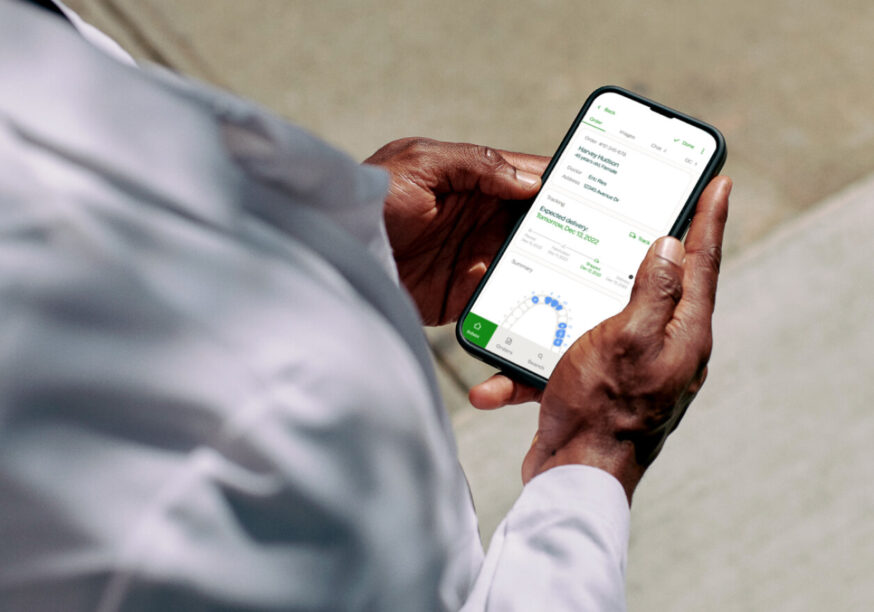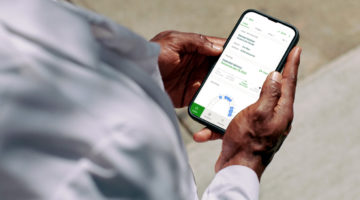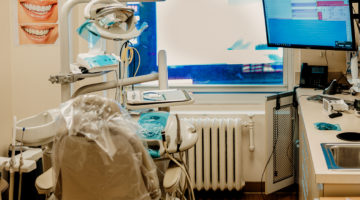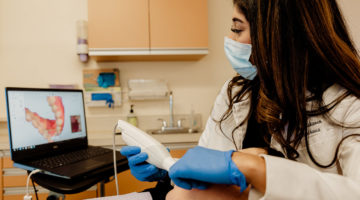Imagine introducing a single change to your practice that can transform patient comfort, increase productivity, and usher a serious ‘wow’ factor into nearly every single appointment. Well, you don’t have to imagine it because all of that and more can be achieved with the introduction of a digital workflow. Dental care is experiencing a revolution.
This isn’t just about a superior impression and visualization process, partnering with a digital dental lab can revolutionize your practice’s workflows. But you might be thinking: it must require a ton of retraining to adopt a digital workflow. Well, as you’ll see a bit later, rather than asking you to unlearn anything or loading you up with overelaborate equipment, a digital workflow in dentistry merely streamlines and simplifies your existing modus operandi.
Read on and you’ll see how adopting a dental digital workflow will enhance your day-to-day dentistry while improving the patient experience.
What is a digital workflow in dentistry?
A digital workflow is dentistry reimagined. By integrating powerful, innovative technology into every step of the dental workflow, dentistry steps into the 21st century. Now you’re fine-tuning with precision, streamlining with efficiency, and improving patient outcomes across the board. And the benefits extend beyond the walls of your practice to the lab. As you will see, cutting-edge 3D printing in dentistry represents a major improvement upon traditional methods in nearly every conceivable way. So what is the digital workflow?
- The digital workflow in dentistry begins with a scan of the patient’s anatomy. A handheld intraoral scanner is inserted into the patient’s mouth. The simple-to-use scanning wand emits and captures painless light pulses. As you scan the patient’s mouth, their digital impression is rendered automatically on a nearby monitor running chairside software. The result is a precision 3D Computer Assisted Design (CAD) digital model of the patient’s entire oral cavity.
- The highly-detailed 3D model of the patient’s mouth may not only be articulated to accurately visualize bite and VDO, it is fully manipulable. This allows close examination of the patient’s anatomy from any angle, as well as a visual representation of planning treatments. Using intuitive software you can jump-start the appliance and restoration fabrication process and enable you to visualize outcomes. But, while important, visualizing and planning are only one aspect of the digital workflow–dentistry is about delivering results.
- Once a treatment plan has been finalized, you may send the design directly from the chairside software to the lab. After inspecting the 3D model, technicians upload the design to either 3D printers for additive manufacturing or a milling machine for subtractive manufacturing, depending on the use-case. Milling machines carve shapes with from solid blocks of material. 3D printers extrude and cure material layer upon layer until the final shape is realized. Both processes continue more or less autonomously and both yield highly detailed, accurate results, including color matching.
- After the appliance or restoration has been inspected by skilled lab technicians, it is packaged and shipped to your practice where the patient will return for fitting. The time between hitting ‘send’ on a patient’s design and receiving the finished piece is about a week to ten days. This is most often the final step in the digital workflow. Dentistry made simple.
Benefits of a digital workflow in dentistry
Accuracy and efficiency
Improved visualization accuracy leads to more consistent restorations, with fewer chairside adjustments or costly re-dos. And without needing to order trays and PVS supplies, there is less operational burden, as well as money saved on impression materials. Overall, revenue increases through faster operator turnover and happier patients.
An elevated dental patient experience
Patients are increasingly seeking dental practices that are more tech-forward.
Why? They want faster appointments, more comfortable impressions, a shorter turnaround time for restorations, and better (and quicker) fits for their restorative procedures. A digital scan can elevate what might once have been a dreaded dental experience, contributing to higher retention and referral rates.
“Patients talk to their friends and family about this new technology… that was a reason for new patient referrals to the office.”
Layla Baidas, DDS
Signature Smiles of Park Ridge
Visuals enhance dental patient case acceptance
If patients better understand what is happening with their teeth and gums, they become more invested in their own care.
Seeing the inside of their mouths on a screen can trigger a participatory reaction, and patients become more invested in treatment as a response— a win-win for patients and dentists alike.
“Digital dentistry has allowed me to show patients what I am doing. It has made the whole appointment educational.”
Delaney Spaulding, DMD
Ross Bridge Dentistry
Sustainability for your dental practice
As climate change becomes less theoretical, many dental practices are looking for more sustainable ways to manage their businesses.
Thankfully digital scanning is better for the environment and your bottom line. No more PVS, trays, or other impression-making materials—and less administrative burden of inventorying, managing, and ordering these supplies—not to mention shipping. Digital dentistry also sets practices up for long-term sustainability, which may also pay off down the line if selling your practice is part of your retirement strategy.
Dental practice modernization
Modernizing operations energizes a practice, making it a more attractive place to work and a more enticing opportunity for future buyers, if you plan to sell.
Many newer dental health professionals prioritize working with digital technologies and look for practices that employ them. Adopting digital workflows can make your practice more attractive for talent acquisition and retention, and you’ll reap the benefits from increased patient referrals.
“Intraoral scanning technology is re-energizing. I really think digital technologies are the now and the future of dentistry.”
Eric M. Block, DMD, CAGS, FICOI
The Stress Free Dentist
There are so many reasons to go digital– whether you’re in it for outcomes, increasing practice efficiency, patient experience, the planet, or increasing the value of your practice. What will yours be?
Implementing digital dental workflows
Implementing a digital workflow in dentistry is more straightforward than you might think. The digital dentistry requires minimal training and integrates intuitively into existing paradigms. An accurate analogy might be moving from a turn-of-the-century, crank-operated automobile to a modern, fully-electric vehicle; some retraining is required, but the essential processes are mirrored, and the latter is inarguably easier, more comfortable, and more efficient than the former. But you know yourself and your team and your practice best, so how to introduce a digital dentistry workflow depends on your goals.
Choosing the right application
One of the most important decisions you must make early is how you will apply digital dentistry to your practice.
With minimal training, you can use an intraoral scanner and design software to perform wellness scans, not only giving you a powerful visual aid, but allowing you to track treatment progress, and more efficiently store patient records.
Producing a 3D diagnostic model is a simple application of the digital dentistry workflow requiring virtually no software manipulation. With just a few clicks a digital model can be sent to the lab where it is 3D printed and shipped to you with minimal turnaround.
Maybe you’re looking for digital workflows to decrease the impact of inefficient yet frequently-prescribed applications, such as splints, surgical guides, or clear aligners. Simple, yet time-consuming, expensive, and fiddly to manufacture by hand, these are an ideal early application of the digital workflow for dentistry. Intuitive chairside software makes design a breeze and since the above-mentioned appliances are constructed from a single biocompatible material that does not need to be color-matched, a lab can print, post-process, and ship them to you within a matter of days. And in the event of loss or breakage, an identical appliance may be reprinted with just a few clicks, no extra visits required.
Once you begin with one application of the digital dentistry workflow, the step to more complex applications is merely a matter of degree; if your practice regularly produces appliances requiring high levels of accuracy and detail, (e.g. full dentures) it almost goes without saying that this streamlined process is invaluable.
Defining and testing a digital dental workflow
Once you know exactly how you will apply a dental digital workflow, you may begin to map out each step from digital impressions to design to manufacturing, noting the ways in which greater efficiency will affect your day-to-day in the short term, and your business’ operation long-term.
Maybe you can now schedule more patients, get training for an assistant to take scans enabling you to more efficiently apply your expertise elsewhere, use your adoption of new tech advertise within your community, widen the scope of services offered. The point is, now that you’ve committed to a digital dental workflow, you are at liberty to brainstorm.
A good place to begin is demoing the scanning and manufacturing process on your team. This will help you concretize timeframes and help you and your team understand all aspects of the undertaking. This also gives you an opportunity to directly compare the product of traditional methods to those derived from digital dentistry. After all, seeing is believing.
If you’re unsure of how to proceed, consider requesting a demo of ways to use your new technology in order to get an idea of the degree of time/resources savings you can expect. To this end, Dandy has many educational resources available alongside real-time support from experts in the clinical, design, and manufacturing fields.
Starting small and expanding accordingly
Once you’ve got a good idea of how you’d like a digital dentistry workflow to be applied to your practice, it may be good to start introducing aspects slowly, one at a time before you ramp up to a fully digital workflow. Dental excellence, after all, requires precision and introducing a dental digital workflow is no exception.
It’s smart to begin implementation with the most basic digital functions. Scans are intuitive and require minimal training, so that is a great starting point. Adding a wellness scan to every appointment will help get you, your staff, and your patients acquainted with the technology and the workflow.
After everyone feels comfortable, you can begin introducing simple design products like splints, clear aligners, or crowns. This will give you a good idea of turnaround times with the lab and the quality you can expect.
Progress can and should continue in this step-by-step process until things become second nature. But you will begin to notice savings of time and resources almost immediately.
A rough outline of a general dentistry practice’s progress from beginner, to intermediate, to advanced is as follows:
Beginner
- Diagnostic models
Intermediate
- Night guards
- Occlusal splints
- Mouthguards
Advanced
- Restorations
- Implant-supported appliances
How Dandy supports digital workflows in dentistry
Dandy is a first-of-its-kind digital dental lab helping to revolutionize the way you do dentistry and improve the patient experience. Partnership with Dandy not only ensures the highest quality products with cutting-edge 3D printing technology, Dandy’s intuitive Chairside software makes everything from impressions to record-keeping to treatment planning easy and intuitive, adding efficiency to every appointment.
Partnering with Dandy makes introducing a digital dentistry workflow a breeze. Not only does our advanced software streamline the treatment planning, design, and manufacturing processes, we’re there with live expert support whenever you might need it. As if that weren’t enough, if you partner with Dandy, we’ll provide a complimentary leading 3Shape TRIOS intraoral scanner.
Curious about joining the digital dentistry revolution? To discover the full potential of a digital dental workflow and what it could mean for your practice, schedule a consultation today and let’s explore the possibilities together.




